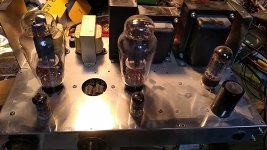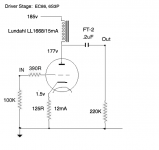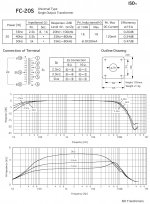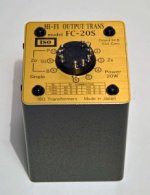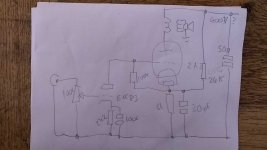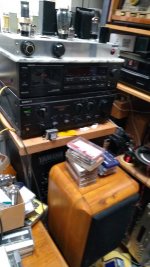I bought this of eBay a few years ago as I figured it was priced not much more than the cost of the parts, and I had a 2A3 itch. It has worked reliably, it came with JJ tubes, I got some Sovteks for day to day.
It was never very convincing though. I recently acquired some Sonus Faber Electas. The 2a3 will, says with gritted teeth work nicely with the Electas, bit they don't. So I finally measured the amp today, it is significantly rolled off at the top and bottom, and manages a whopping 1.5 watts with the Sovteks, and 2 watts with the JJs.
I have been plotting their reinvention for some time, and have just got some ISO FC20s, and am open to ideas for a circuit, but I feel maybe a three stage with SRPP driving the grid, or maybe fixed bias and a cathode follower for the grid.


It was never very convincing though. I recently acquired some Sonus Faber Electas. The 2a3 will, says with gritted teeth work nicely with the Electas, bit they don't. So I finally measured the amp today, it is significantly rolled off at the top and bottom, and manages a whopping 1.5 watts with the Sovteks, and 2 watts with the JJs.
I have been plotting their reinvention for some time, and have just got some ISO FC20s, and am open to ideas for a circuit, but I feel maybe a three stage with SRPP driving the grid, or maybe fixed bias and a cathode follower for the grid.
Attachments
I recently acquired some Sonus Faber Electas. The 2a3 will, says with gritted teeth work nicely with the Electas, bit they don't. So I finally measured the amp today, it is significantly rolled off at the top and bottom, and manages a whopping 1.5 watts with the Sovteks, and 2 watts with the JJs.
On the surface, that would seem to be a poor pairing. Which version of the Electas? There seems to be many different versions.
jeff
The OPTs look quite small, and maybe were more like radio or guitar parts. Not premium quality by the look of it. There's not much room for anything bigger, though. I'd be looking to change the OPTs. I love my LL1682/50 OPTs, and they would match - would they go under the top plate? £99 each from Blore Edwards.
You could try an EC86 as driver tube, or the Russian 6S3P equivalent.
This could all be rebuilt on a larger chassis with room for proper OPTs. .
You could try an EC86 as driver tube, or the Russian 6S3P equivalent.
This could all be rebuilt on a larger chassis with room for proper OPTs. .
The last time I owned a SF it was the Signum, which played tolerably well with a pp 2A3 making about 16W. They were much, much happier with JR Model 7 monoblocks.
If SRPP , why 3 stage? 'Seen the Baby Ongaku?
For another idea, a grounded grid circuit. You could put an interstage secondary in the cathode of the 2a3 and make a small power amp to drive it. One nice thing about it is that a good part of the power used to drive the cathode shows up at the output so if you drive the 2a3 with round things those round things may be audible at the output. They can sound very good.
Another idea is to use JC Morrison's circuit here (Maybe this one is the most easily doable and looks like you can get a decent bit more grunt from a circuit using the 2a3.)
Or, get Frank Blöhbaum's Linear Audio articles on his Multiplied Transconductance Amplifier circuit. The little 3.5 watt power amp circuit in Linear Audio V6 is really impressive - very clean with low end that is deep and well controlled in an albeit sensitive 15" woofer.
For another idea, a grounded grid circuit. You could put an interstage secondary in the cathode of the 2a3 and make a small power amp to drive it. One nice thing about it is that a good part of the power used to drive the cathode shows up at the output so if you drive the 2a3 with round things those round things may be audible at the output. They can sound very good.
Another idea is to use JC Morrison's circuit here (Maybe this one is the most easily doable and looks like you can get a decent bit more grunt from a circuit using the 2a3.)
Or, get Frank Blöhbaum's Linear Audio articles on his Multiplied Transconductance Amplifier circuit. The little 3.5 watt power amp circuit in Linear Audio V6 is really impressive - very clean with low end that is deep and well controlled in an albeit sensitive 15" woofer.
Attachments
Looking at the size of the Mains transformer and the choke, it looks like you could rebuild this on a bigger chassis and use 300b outputs. They would sound great with a pair of LL1682/50mA. That's what I'm using as my daily amp. I would use a 50VA transformer 9v + 9v and feed the DC into Rod Coleman regs, see Lyrima. That would give you 11v into the regs, perfect. Many of us use his excellent regs for DHTs.
Here's a front end you could use with an EC86 aka Russian 6S3P-EV. Values are as the data sheet. The Lundahl LL1668/15mA would make a nice anode choke, and the coupling cap would be a Russian teflon FT-2 or FT-3. Parallel for 0.2uF or just use 0.1uF singly. You will get very detailed sound. You can also experiment with other driver tubes in the same setup. You can leave out the cathode bypass cap since the LL1668/15mA has plenty of inductance at 167H.
https://frank.pocnet.net/sheets/020/e/EC86.pdf
Here's a front end you could use with an EC86 aka Russian 6S3P-EV. Values are as the data sheet. The Lundahl LL1668/15mA would make a nice anode choke, and the coupling cap would be a Russian teflon FT-2 or FT-3. Parallel for 0.2uF or just use 0.1uF singly. You will get very detailed sound. You can also experiment with other driver tubes in the same setup. You can leave out the cathode bypass cap since the LL1668/15mA has plenty of inductance at 167H.
https://frank.pocnet.net/sheets/020/e/EC86.pdf
Attachments
Last edited:
hbc,
Let's find out some more facts, and then perhaps we can make additional educated guesses and ideas.
There might, or might not, need to be a lot of re-engineering, re-parting, or circuit changes, etc.
I do agree that new output transformers might be in order; but without more details like circuit values, voltages, input tub type, signal sources, speaker characteristics, etc., we will not even know what primary impedance and what secondary impedance, are required for optimal operation.
Is there enough gain on the amp now to drive the 2A3 into clipping?
What is the signal source, a CD player with 2.1Vrms (3V Peak)?
Or a phono preamp with 0.5Vrms (0.7V Peak) output?
How did you get 1.5W or 2.0 Watts output (a signal generator, how many volts? and a load resistor of how many Ohms)?
Does 1.5W or 2W sound loud enough on the Sonus Fabers? (if there is not enough amplifier gain, and your signal source, you may not even get 1.5 or 2 Watts into the speaker.
What is the Rated Sensitivity of the Sonus Faber Electa?
What is the DCR of the Sonus Faber Electa?
As much trouble as it is to draw a schematic . . .
Please post a complete schematic of the amplifier, including voltages.
Le's attack this unknown amplifier to make it the best it can be versus the additional money spent to make it good.
Let's find out some more facts, and then perhaps we can make additional educated guesses and ideas.
There might, or might not, need to be a lot of re-engineering, re-parting, or circuit changes, etc.
I do agree that new output transformers might be in order; but without more details like circuit values, voltages, input tub type, signal sources, speaker characteristics, etc., we will not even know what primary impedance and what secondary impedance, are required for optimal operation.
Is there enough gain on the amp now to drive the 2A3 into clipping?
What is the signal source, a CD player with 2.1Vrms (3V Peak)?
Or a phono preamp with 0.5Vrms (0.7V Peak) output?
How did you get 1.5W or 2.0 Watts output (a signal generator, how many volts? and a load resistor of how many Ohms)?
Does 1.5W or 2W sound loud enough on the Sonus Fabers? (if there is not enough amplifier gain, and your signal source, you may not even get 1.5 or 2 Watts into the speaker.
What is the Rated Sensitivity of the Sonus Faber Electa?
What is the DCR of the Sonus Faber Electa?
As much trouble as it is to draw a schematic . . .
Please post a complete schematic of the amplifier, including voltages.
Le's attack this unknown amplifier to make it the best it can be versus the additional money spent to make it good.
Read his post lads. He did say that he already has the new output transformers. They look pretty nice too. (Lots of current headroom if you decide to try the JC Morrison idea.)
Andy's EC86 driver tube suggestion is good too. You could put that tube with Rod Coleman's shunt cascode driver board. (I think Rod uses it to drive a 300B)
If you look at Blöhbaum's MTA you could use a small signal tube with his anode circuit to get a very good driver as well, though that takes you into the realm of feedback, which might be more learning curve than you feel like.
Ahh, but hbc, you already have your eye on a three stage circuit , why not.
One thing I took away from an interview with Frank B. was his talking about restricting the tubes he uses to their linear range of operation, rather than focusing on extracting a lot of swing. Makes sense to me. A lot has been said about avoiding more stages but maybe they're all wrong. 🙂
Have some adventure spirit there boys ! There are lots of possibilities!
Andy's EC86 driver tube suggestion is good too. You could put that tube with Rod Coleman's shunt cascode driver board. (I think Rod uses it to drive a 300B)
If you look at Blöhbaum's MTA you could use a small signal tube with his anode circuit to get a very good driver as well, though that takes you into the realm of feedback, which might be more learning curve than you feel like.
Ahh, but hbc, you already have your eye on a three stage circuit , why not.
One thing I took away from an interview with Frank B. was his talking about restricting the tubes he uses to their linear range of operation, rather than focusing on extracting a lot of swing. Makes sense to me. A lot has been said about avoiding more stages but maybe they're all wrong. 🙂
Have some adventure spirit there boys ! There are lots of possibilities!
Attachments
The ISO FC20s is a great OPT for 2a3. You will like it. I have some even better OPT's but they are:
1. more expensive
2. bigger and heavier.
3. For most speakers, not hugely better than Tango XE-20s (which the ISO FC20s is based on).
I see the mains transformer and choke. What are they? Hammond? Know the models?
Hammond, despite people often dismissing them have decent power iron and post most impeccable datasheets, which makes simulation easy.
These look like the Hammond "Classic" kind. Since you are in the UK they kind of must be. Maybe 370X or similar. Looks like there is an electrolytic cap after the rectifier...
Then there seems to be maybe a big motor-run cap after the choke. A rough schematic would be a huge help. I assume the rectifier is GZ34/5AR4 type.
The chassis looks to be of the thinner, Asian style, so getting new iron into it would be challenging. But it has a chrome look and appears quite nice. I am sure it could be sold if it is not to your liking.
These days I would be partial to lower B+ with fixed bias using an interstage transformer (from Lundahl). I would use choke input power supply and only film caps. I would be tempted to use a gyrator on the input stage. But if you prefer, use a coupling cap instead.
2 stage is the way to go. EC86 is quite fine, but there are of course other possibilities. I am using triode strapped C3g since I bought them cheap years ago.
1. more expensive
2. bigger and heavier.
3. For most speakers, not hugely better than Tango XE-20s (which the ISO FC20s is based on).
I see the mains transformer and choke. What are they? Hammond? Know the models?
Hammond, despite people often dismissing them have decent power iron and post most impeccable datasheets, which makes simulation easy.
These look like the Hammond "Classic" kind. Since you are in the UK they kind of must be. Maybe 370X or similar. Looks like there is an electrolytic cap after the rectifier...
Then there seems to be maybe a big motor-run cap after the choke. A rough schematic would be a huge help. I assume the rectifier is GZ34/5AR4 type.
The chassis looks to be of the thinner, Asian style, so getting new iron into it would be challenging. But it has a chrome look and appears quite nice. I am sure it could be sold if it is not to your liking.
These days I would be partial to lower B+ with fixed bias using an interstage transformer (from Lundahl). I would use choke input power supply and only film caps. I would be tempted to use a gyrator on the input stage. But if you prefer, use a coupling cap instead.
2 stage is the way to go. EC86 is quite fine, but there are of course other possibilities. I am using triode strapped C3g since I bought them cheap years ago.
Also, Sonus Faber Electas are 2-way and have something like 88db sensitivity. Single ended 2a3 or even 300b is not really going to be enough for them. It will work, but the magic won't be there.
I would build a push-pull amplifier instead to power them. Single ended 2a3 powering higher sensitivity full range speakers is pretty darn good. 2-way can work too if the speaker sensitivity is high enough, but I doubt you will find such a speaker in "bookshelf" size.
Ian
I would build a push-pull amplifier instead to power them. Single ended 2a3 powering higher sensitivity full range speakers is pretty darn good. 2-way can work too if the speaker sensitivity is high enough, but I doubt you will find such a speaker in "bookshelf" size.
Ian
Also, Sonus Faber Electas are 2-way and have something like 88db sensitivity. Single ended 2a3 or even 300b is not really going to be enough for them. It will work, but the magic won't be there. I would build a push-pull amplifier instead to power them. Single ended 2a3 powering higher sensitivity full range speakers is pretty darn good. 2-way can work too if the speaker sensitivity is high enough, but I doubt you will find such a speaker in "bookshelf" size. Ian
It all depends how big the room is and how loud you listen. I use a 2 stage 300b SE amp. I have 2 pairs of speakers - Mark Audio Alpair 10M single units at 89db sensitivity, and Wharfedale 2-way bookshelf speakers 86db sensitivity. Both are fine in a room 3.40 x 4.40m. I don't listen loud. So under those conditions all the magic is there. Bigger and louder, don't know. But it would be a shame to go push pull.
I overlooked the ISO-20 OPTs. Should be great for a 300b SE amp. As said, Hammond mains transformers and chokes are pretty good. I would always recommend DC Link caps for 300b cathode bypass (40uF up) and the last PSU cap. Kemet are not too large and good value.
Measurements:
I had not really looked into this amp previously, as it works and not familiar with no feedback DHTs, kind of assumed the builder knew what they were doing.....
HT 350 v
Cathode voltage 130 jj and sovtec quite close so..
gives anode current 43mA and 9 watt anode dissipation.
ECC83's (both halves paralleled) anode resistor, 100k droping 41 volts,
so about 68 volts across the 83s
The output TX is 2.5k on 4 ohm tap and 2.8k on 8 ohm tap
The taps were wired the opposite way from what I expected, (0-8-4) so I have some new more scientific power measurements, at a randomly selected 7% distortion. This is for the JJ tube. The sovtek is marginaly less.
Output power in watts
tap / load 4_____8
8_________ 1_____1.5
4__________1.4___1.2
That and with the roll off, starting at 7k, 4dB down by 20k, and the bass similarly sad, not suprising the SF's (original Electa) are not making happy noises. Was a bit of a depressing time, but now I am running them on my (own design) 6V6 SE amp 3.5 watts and they are much happier, I think the SFs would probably work best with 20-30 watts with a lowish output impedance, but thats a future project(s) 🙂.
As the JJ 2A3 is supposed to be a 300B with 2.5v heater it should be possible to get at least 6 watts out of them?
The iron is all Hammond iirc and the plan is to keep the power and choke. No idea what the big black cap is, but it wired to the output of the GZ34 and before the choke, after the choke is a dual cap 50 + 50 uF with both halves connected together...
400v should read 350v, and 50u should be 100u 🙂.
Cathode resistor 3k

briefly in situ, now on the bench:

This is the circuit I found in my wanderings of the web:

2A3 and 45 single ended amplifier
Looks kind of Japanese, and we don't mind leaning in that direction for this amp.
I had not really looked into this amp previously, as it works and not familiar with no feedback DHTs, kind of assumed the builder knew what they were doing.....
HT 350 v
Cathode voltage 130 jj and sovtec quite close so..
gives anode current 43mA and 9 watt anode dissipation.
ECC83's (both halves paralleled) anode resistor, 100k droping 41 volts,
so about 68 volts across the 83s
The output TX is 2.5k on 4 ohm tap and 2.8k on 8 ohm tap
The taps were wired the opposite way from what I expected, (0-8-4) so I have some new more scientific power measurements, at a randomly selected 7% distortion. This is for the JJ tube. The sovtek is marginaly less.
Output power in watts
tap / load 4_____8
8_________ 1_____1.5
4__________1.4___1.2
That and with the roll off, starting at 7k, 4dB down by 20k, and the bass similarly sad, not suprising the SF's (original Electa) are not making happy noises. Was a bit of a depressing time, but now I am running them on my (own design) 6V6 SE amp 3.5 watts and they are much happier, I think the SFs would probably work best with 20-30 watts with a lowish output impedance, but thats a future project(s) 🙂.
As the JJ 2A3 is supposed to be a 300B with 2.5v heater it should be possible to get at least 6 watts out of them?
The iron is all Hammond iirc and the plan is to keep the power and choke. No idea what the big black cap is, but it wired to the output of the GZ34 and before the choke, after the choke is a dual cap 50 + 50 uF with both halves connected together...
400v should read 350v, and 50u should be 100u 🙂.
Cathode resistor 3k
briefly in situ, now on the bench:
This is the circuit I found in my wanderings of the web:

2A3 and 45 single ended amplifier
Looks kind of Japanese, and we don't mind leaning in that direction for this amp.
Attachments
Last edited:
Well, the EF86 is to make it an integrated amp. If you already have a preamp you could just start with the srpp driver. (again have a look at the Baby-O schema as well.)
As you probably can guess from my posts, I try my best to push the explorative side as there are many here with LOTS of experience who will kindly suggest what they think is the best course to a finished product. My push is to follow your nose and just try stuff to get a feel for what can do what , what parts of a circuit influence the outcome in what way. I'm not selling anything other than that.
So, if me, just to start , I'd leave everything the same and just stick in the new output transformers to hear what they do differently, even trying different impedance options . . . . . and while listening to them for a few days, make your plan of attack on the new amp circuit.
As you probably can guess from my posts, I try my best to push the explorative side as there are many here with LOTS of experience who will kindly suggest what they think is the best course to a finished product. My push is to follow your nose and just try stuff to get a feel for what can do what , what parts of a circuit influence the outcome in what way. I'm not selling anything other than that.
So, if me, just to start , I'd leave everything the same and just stick in the new output transformers to hear what they do differently, even trying different impedance options . . . . . and while listening to them for a few days, make your plan of attack on the new amp circuit.
The OP’s amp looks like this: The 2A3 Tube Amplifier - A Tribute to Simplicity and Warm Sound | audioXpress
The OP's amp schematic looks like a sorta kinda Free Lunch/Monkey on a Stick without the 6C45P input/driver.
Question to hbc. Have you tried your amp with the 24K resistor from B+ to cathode disconnected? Just curious.
Question to hbc. Have you tried your amp with the 24K resistor from B+ to cathode disconnected? Just curious.
NickKuK,
The schematic in Post # 14 shows a GZ34 with a 100uF first filter cap.
The Telefunken data sheet at Franks Tube Data shows a maximum 60uF filter cap.
For a GZ34 with a 100uF first filter cap . . .
Your Mileage May Vary.
The schematic in Post # 14 shows a GZ34 with a 100uF first filter cap.
The Telefunken data sheet at Franks Tube Data shows a maximum 60uF filter cap.
For a GZ34 with a 100uF first filter cap . . .
Your Mileage May Vary.
NickKuK,
The schematic in Post # 14 shows a GZ34 with a 100uF first filter cap.
The Telefunken data sheet at Franks Tube Data shows a maximum 60uF filter cap.
For a GZ34 with a 100uF first filter cap . . .
Your Mileage May Vary.
Good point I have a figure of about 74uF max for tube rectification.
Hmm, lots to think about, The MTA and JM labs look interesting, I always look at the JM with interest, his brain works a bit like mine concocting interesting circuit, but he seems to do it for an audio dayjob!
I want to stay mostly sand free, the odd solid state diode I don't mind for bias voltages, but the purpose of this amp, it is my first DHT no feedback (probably) triode amp, and I want to have that experience. In the short term it is going to be converted to a baby ongaku circuit, as it is almost there already. I have quite a few other transformers I would like to test as well, so I may as well do that here.
Thanks for the link to the Lundals Andy, put a pair of them on my list of things to buy when I have some spare money.
I don't really want to do interstage transformers, although the cathode drive does sound interesting. Will have to look into the EC86, with an anode choke, that has an interesting possibility, if I used a stabilised supply for it, I can see a way to direct couple to my cathode follower to drive the 2A3s grid...
The case was completely scratch built by the guy I bought it off, and he did a nice job, but not really to my liking, so I striped it down a bit. I have a 1950 military power supply, well 2 actually, I am going put the 2A3 in to one, and the other is getting my take on an EAR 859.
Hopefully the baby ongaku circuit will get me a bit closer to 3.5watts with the sovtek 2A3. with the JJ2A3-40 I guess I will need to go to fixed bias (my preference) and a bit more current to get more output power with the 350 volt rail.
I want to stay mostly sand free, the odd solid state diode I don't mind for bias voltages, but the purpose of this amp, it is my first DHT no feedback (probably) triode amp, and I want to have that experience. In the short term it is going to be converted to a baby ongaku circuit, as it is almost there already. I have quite a few other transformers I would like to test as well, so I may as well do that here.
Thanks for the link to the Lundals Andy, put a pair of them on my list of things to buy when I have some spare money.
I don't really want to do interstage transformers, although the cathode drive does sound interesting. Will have to look into the EC86, with an anode choke, that has an interesting possibility, if I used a stabilised supply for it, I can see a way to direct couple to my cathode follower to drive the 2A3s grid...
The case was completely scratch built by the guy I bought it off, and he did a nice job, but not really to my liking, so I striped it down a bit. I have a 1950 military power supply, well 2 actually, I am going put the 2A3 in to one, and the other is getting my take on an EAR 859.
Hopefully the baby ongaku circuit will get me a bit closer to 3.5watts with the sovtek 2A3. with the JJ2A3-40 I guess I will need to go to fixed bias (my preference) and a bit more current to get more output power with the 350 volt rail.
Ì have wired it as a baby ongaku circuit and it now behaves decently with 4.8 watts at 7% distortion, and 1 dB down at 40 Hz, and 20kHz. Is it a good match for the Electas? I feel they need an amp with a little bit more sizzle in the top, nut I feel there is plenty of texture in the bids, and a bit of hum..... The only time I spent some time with some Sonus Fabers in the past was some smaller ones, I think minimas, and they seemed a bit brighter, but happy on the output of an EAR 859. Anyway it doesn't sound broken anymore.
This is where I am at the moment. I am sure there are some gotchas I haven't considered yet. The output bias can be set by adjusting V2

Did I say my current fetish is to not have any caps in the signal path? I am sure C1 could be removed without much effort.
This is where I am at the moment. I am sure there are some gotchas I haven't considered yet. The output bias can be set by adjusting V2
Did I say my current fetish is to not have any caps in the signal path? I am sure C1 could be removed without much effort.
Attachments
Why do you need a cathode follower? A teflon FT-2 cap would be simpler. Don't find that teflon coupling caps change the sound much.
- Home
- Amplifiers
- Tubes / Valves
- Help me re-engineer my 2A3 amp.
